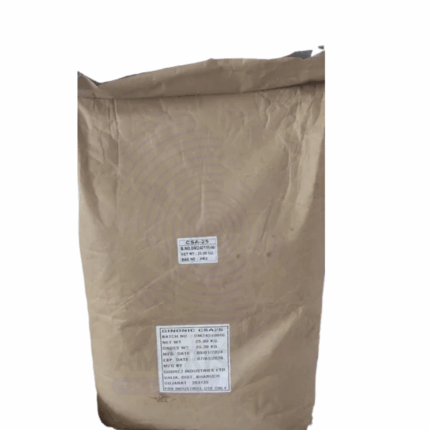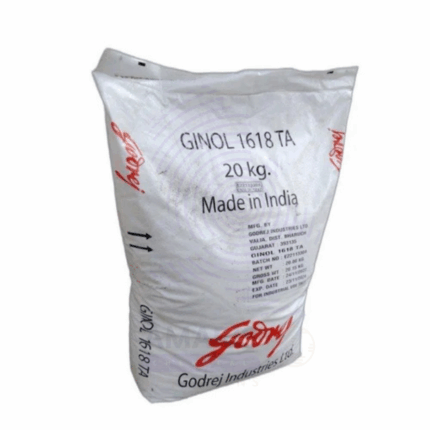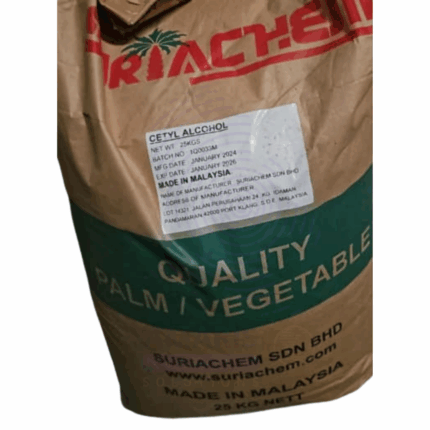White Microwax Odourless
White Microwax Odourless is a high-purity, refined microcrystalline wax characterized by its white color and lack of odor. It offers excellent flexibility, adhesion, and moisture resistance, making it ideal for use in cosmetics, pharmaceuticals, food packaging, and polishes. This wax has a fine crystalline structure, which imparts smooth texture and superior performance in formulations requiring a neutral scent and stable consistency.
White Microwax Odourless
Primary Uses
Cosmetic Industry
- Lip Balms & Creams: Used as a thickening and emollient agent providing smooth texture and enhanced stability.
- Hair Care Products: Acts as a binder and film-former in styling products.
- Skin Care: Provides occlusive properties for moisture retention in lotions and creams.
Pharmaceutical Industry
- Ointments & Topicals: Serves as a base ingredient offering controlled consistency and spreadability.
- Capsule Coatings: Used in coating formulations to improve texture and appearance.
Food Industry
- Food Packaging & Coatings: Applied as a moisture barrier and surface coating on packaging materials and confectionery.
Polish & Lubricant Industry
- Shoe & Furniture Polish: Imparts shine, water resistance, and smooth finish to polishes.
- Lubricants: Used in specialty lubricants requiring odorless wax bases.
Secondary Uses
Candle Making
- Specialty Candles: Incorporated to enhance burn quality and scent neutrality.
Printing Industry
- Ink Additive: Used to improve gloss and texture in printing inks.
Rubber Industry
- Processing Aid: Acts as a lubricant and anti-blocking agent during rubber processing.
Basic Identification Attributes
- Chemical Name (IUPAC): Microcrystalline wax (complex mixture of saturated hydrocarbons)
- Common/Trade Name: White Microwax Odourless
- CAS Number: 63231-60-7 (typical microcrystalline wax)
- HS Code: 2712.10.00
- Synonyms: Microcrystalline wax, Odourless white wax
Physical & Chemical Properties
- Physical State: Solid wax flakes or pastilles
- Color & Odor: White; odorless
- Melting Point: 60–85 °C (depending on grade)
- Solubility: Insoluble in water; soluble in hydrocarbons and oils
- Density: Approx. 0.90–0.95 g/cm³
- Texture: Fine crystalline structure with excellent plasticity
Safety & Hazard Attributes
- GHS Classification: Not classified as hazardous
- Toxicity: Low toxicity; considered safe for use in cosmetics and food-contact applications
- Exposure Limits: No specific occupational exposure limits established
Storage & Handling Attributes
- Storage Conditions: Store in a cool, dry, well-ventilated area away from direct sunlight and ignition sources
- Container Type: Bags, drums, or bulk packaging
- Shelf Life: 24 months under recommended storage
- Handling Precautions: Avoid dust generation and exposure to high heat
Regulatory & Compliance Attributes
- Complies with: FDA regulations for indirect food contact, cosmetic safety standards, and pharmaceutical excipient guidelines
- Manufactured under: Good Manufacturing Practices (GMP)
- Environmental Compliance: Meets REACH and other major chemical safety regulations
Environmental & Health Impact
- Biodegradability: Slowly biodegradable
- Ecotoxicity: Low environmental impact when properly disposed of
- Bioaccumulation: Not significant
Safety Handling Precautions
- PPE Required: Gloves and safety glasses recommended during handling
- Handling Guidelines: Use adequate ventilation; avoid inhalation of dust and prolonged skin contact
- Storage Measures: Keep containers sealed to prevent contamination and moisture uptake
First Aid Measures
- Inhalation: Move to fresh air; seek medical attention if respiratory symptoms occur
- Skin Contact: Wash affected area with soap and water
- Eye Contact: Rinse thoroughly with water for 15 minutes; seek medical advice if irritation persists
- Ingestion: Rinse mouth; consult a physician if necessary
Firefighting Measures
- Fire Hazards: Combustible solid wax
- Extinguishing Media: Use foam, dry chemical, or CO₂ extinguishers
- Hazardous Combustion Products: Carbon oxides and hydrocarbons


 Preservatives(food)
Preservatives(food) Flavor Enhancers
Flavor Enhancers Acidulants
Acidulants Sweeteners
Sweeteners Antioxidants
Antioxidants Colorants(food)
Colorants(food) Nutraceutical Ingredients (food)
Nutraceutical Ingredients (food) Nutrient Supplements
Nutrient Supplements Emulsifiers
Emulsifiers
 Collectors
Collectors Dust Suppressants
Dust Suppressants Explosives and Blasting Agents
Explosives and Blasting Agents Flocculants and Coagulants
Flocculants and Coagulants Frothers
Frothers Leaching Agents
Leaching Agents pH Modifiers
pH Modifiers Precious Metal Extraction Agents
Precious Metal Extraction Agents
 Antioxidants(plastic)
Antioxidants(plastic) Colorants (Pigments, Dyes)
Colorants (Pigments, Dyes) Fillers and Reinforcements
Fillers and Reinforcements Flame Retardants
Flame Retardants Monomers
Monomers Plasticizers
Plasticizers Polymerization Initiators
Polymerization Initiators Stabilizers (UV, Heat)
Stabilizers (UV, Heat)
 Antifoaming Agents
Antifoaming Agents Chelating Agents
Chelating Agents Coagulants and Flocculants
Coagulants and Flocculants Corrosion Inhibitors
Corrosion Inhibitors Disinfectants and Biocides
Disinfectants and Biocides Oxidizing Agents
Oxidizing Agents pH Adjusters
pH Adjusters Scale Inhibitors( water)
Scale Inhibitors( water)
 Antioxidants(cosmetic)
Antioxidants(cosmetic) Emollients
Emollients Fragrances and Essential Oils
Fragrances and Essential Oils Humectants
Humectants Preservatives
Preservatives Surfactants(cosmetic)
Surfactants(cosmetic) Thickeners
Thickeners UV Filters
UV Filters
 Fertilizers
Fertilizers Soil Conditioners
Soil Conditioners Plant Growth Regulators
Plant Growth Regulators Animal Feed Additives
Animal Feed Additives Biostimulants
Biostimulants Pesticides (Herbicides, Insecticides, Fungicides)
Pesticides (Herbicides, Insecticides, Fungicides)
 Active Pharmaceutical Ingredients (APIs)
Active Pharmaceutical Ingredients (APIs) Excipients
Excipients Solvents(pharmaceutical)
Solvents(pharmaceutical) Antibiotics
Antibiotics Antiseptics and Disinfectants
Antiseptics and Disinfectants Vaccine Adjuvants
Vaccine Adjuvants Nutraceutical Ingredients (pharmaceutical)
Nutraceutical Ingredients (pharmaceutical) Analgesics & Antipyretics
Analgesics & Antipyretics
 Analytical Reagents
Analytical Reagents Solvents(lab)
Solvents(lab) Chromatography Chemicals
Chromatography Chemicals Spectroscopy Reagents
Spectroscopy Reagents microbiology-and-cell-culture-reagents
microbiology-and-cell-culture-reagents Molecular Biology Reagents
Molecular Biology Reagents Biochemical Reagents
Biochemical Reagents Inorganic and Organic Standards
Inorganic and Organic Standards Laboratory Safety Chemicals
Laboratory Safety Chemicals Specialty Laboratory Chemicals(Special Laboratory Equipment)
Specialty Laboratory Chemicals(Special Laboratory Equipment)
 Demulsifiers
Demulsifiers Hydraulic Fracturing Fluids
Hydraulic Fracturing Fluids Scale Inhibitors(oil)
Scale Inhibitors(oil) Surfactants(oil)
Surfactants(oil) Drilling Fluids
Drilling Fluids
 Dyes and Pigments
Dyes and Pigments Bleaching Agents
Bleaching Agents Softening Agents
Softening Agents Finishing Agents
Finishing Agents Antistatic Agents
Antistatic Agents
 Admixtures
Admixtures Waterproofing Agents
Waterproofing Agents Sealants and Adhesives
Sealants and Adhesives Curing Compounds
Curing Compounds Concrete Repair Chemicals
Concrete Repair Chemicals Anti-Corrosion Coatings
Anti-Corrosion Coatings
 Surfactants(cleaning)
Surfactants(cleaning) Builders
Builders Enzymes
Enzymes Solvents (Cleaning)
Solvents (Cleaning) Fragrances
Fragrances
 Electronic Chemicals
Electronic Chemicals Catalysts
Catalysts Lubricants
Lubricants Photographic Chemicals
Photographic Chemicals Refrigerants
Refrigerants Automotive chemicals
Automotive chemicals Pyrotechnic Chemicals
Pyrotechnic Chemicals
 Biodegradable Surfactants
Biodegradable Surfactants Bio-based Solvents
Bio-based Solvents Renewable Polymers
Renewable Polymers Carbon Capture Chemicals
Carbon Capture Chemicals Wastewater Treatment Chemicals
Wastewater Treatment Chemicals
 Pigments
Pigments Solvents(paint)
Solvents(paint) Specialty Coatings
Specialty Coatings Binders/Resins
Binders/Resins Additives
Additives Driers
Driers Anti-Corrosion Agents
Anti-Corrosion Agents Functional Coatings
Functional Coatings Application-Specific Coatings
Application-Specific Coatings
 Fresh Herbs
Fresh Herbs Ground Spices
Ground Spices Whole Spices
Whole Spices Spice Blends
Spice Blends Dried Herbs
Dried Herbs
 Leavening Agents
Leavening Agents Dough Conditioners
Dough Conditioners Flour Treatments
Flour Treatments Fat Replacers
Fat Replacers Decoratives
Decoratives Preservatives(baking)
Preservatives(baking)
 Plasticizers & Softeners
Plasticizers & Softeners Reinforcing Agents
Reinforcing Agents Adhesion Promoters
Adhesion Promoters Vulcanizing Agents
Vulcanizing Agents Antidegradants
Antidegradants Blowing Agents
Blowing Agents Fillers & Extenders
Fillers & Extenders Accelerators & Retarders
Accelerators & Retarders























